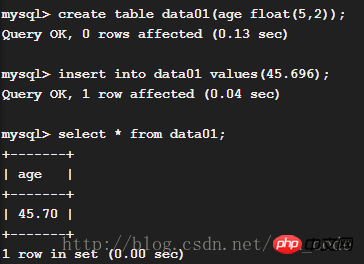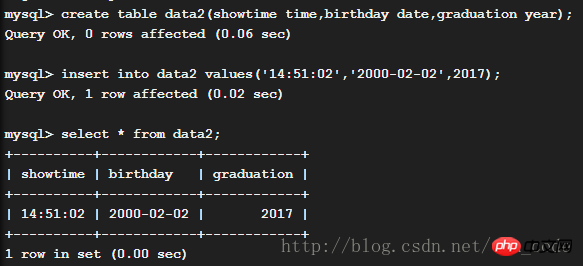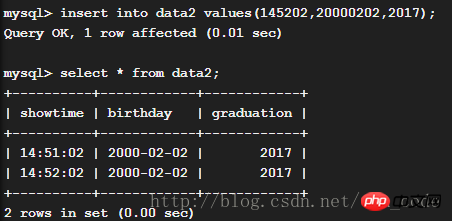In-depth understanding of MySQL advanced drifting (1)
Numeric types:
Numeric types are roughly divided into two categories: one is an integer, and the other is a floating point number or decimal.
The commonly used integer type is the int type, and the allowed range is between (-2147483648, 2147483648).
Commonly used types of floating point numbers or decimals are: float, double and decimal types.
float type (single-precision floating-point value);
double type (double-precision floating-point value);
decimal type (used in calculations that require very high accuracy;
these The type allows specifying the precision and counting method of the value as selection parameters. The precision here refers to the total number of significant digits saved for this value, and the counting method represents the number of digits after the decimal point)
1 2 3 |
|

String type:
Commonly used string types are: char, varchar, text and blob types
char type: used for fixed-length characters Strings must be defined within parentheses with a size modifier that ranges from 0 to 255 and specifies the length of the value to be stored.
Varchar type: It is a variant of the char type, used for variable-length strings, and must also have a size indicator ranging from 0 to 255. The difference lies in the way MySQL handles this indicator. :char treats this size as the exact size of the value, while the varchar type treats it as the maximum size and only uses the number of bytes actually needed to store the string. So using this type is a good choice if you are not sure how many characters a field will store.
For relatively long strings, MySQL provides two types: text and blob. They have different subtypes according to the size of the data to be stored, which are used to store images, large text, and sound files. binary data. The difference is: blob types are case-sensitive, text types are not.
Date event type:
MySQL uses date and year types to describe simple date values, and uses the time type to describe time values. The values can be described as strings or sequences of integers without delimiters.
If described as a string,
Values of date type should be separated by hyphens as delimiters, values of time type should be separated by colons as delimiters, and values of year type must be separated by 4 For digital storage, MySQL will automatically convert: convert the values in the range of 00~69 to the range of 2000~2069, and convert the values in the range of 70~99 to the range of 1970~1999. For example:
1 2 3 |
|

002) insert into data2 values(145202,20000202,2017);
//The result is the same as (001)
In addition to date and time data types, MySQL also supports a hybrid type:
datetime and timestamp data types, which can store date and time as a single value component.
These two types are commonly used to automatically store timestamps containing the current date and time, and can come in handy for applications that perform a large number of database transactions and need to establish an audit trail for debugging and review purposes.
If the first field statement in a row is of type timestamp, and this field is not explicitly assigned a value or is assigned a null value, MySQL will automatically fill it with the current date and time.
Using MySQL's now() function to fill in the current date and time in the statement's datetime type field can get the same result.
Data type selection:
Data classification can play an important role in making stored data more consistent and improving efficiency and speed. Therefore, the choice of data types is very important when designing a database, and all issues involved should be fully considered before making a choice from the multiple sets of options available with MySQL.
Listed below are several criteria that need to be kept in mind when selecting data types for MySQL:
Allowed values, the range and type of values allowed to be entered in a field determine which The data type is the most direct factor added to this field.
Storage efficiency, it is also important to consider the range of possible values for the field and select an appropriate and appropriately sized data type based on this range, especially when dealing with numeric types.
Format and display requirements, another important factor affecting the selection of field types is the application format and display requirements of the data stored in the field.
Data processing requirements, the selection of data types should also consider the requirements of data operations and application processing. For example, some types are more suitable for speeding up data operations than others.
Sort, index, and comparison requirements. If you want to sort all the values in a column by different criteria, then we need to choose a type that can perform these functions efficiently and with maximum flexibility. Adding an index to the corresponding field can speed up retrieval. The type of comparison should also be the data type used. It is necessary to ensure that the data types used support comparison operations and are compatible with each other.
The above is the detailed content of In-depth understanding of MySQL advanced drifting (1). For more information, please follow other related articles on the PHP Chinese website!

Hot AI Tools

Undresser.AI Undress
AI-powered app for creating realistic nude photos

AI Clothes Remover
Online AI tool for removing clothes from photos.

Undress AI Tool
Undress images for free

Clothoff.io
AI clothes remover

Video Face Swap
Swap faces in any video effortlessly with our completely free AI face swap tool!

Hot Article

Hot Tools

Notepad++7.3.1
Easy-to-use and free code editor

SublimeText3 Chinese version
Chinese version, very easy to use

Zend Studio 13.0.1
Powerful PHP integrated development environment

Dreamweaver CS6
Visual web development tools

SublimeText3 Mac version
God-level code editing software (SublimeText3)

Hot Topics
 1677
1677
 14
14
 1430
1430
 52
52
 1333
1333
 25
25
 1278
1278
 29
29
 1257
1257
 24
24
 Laravel Introduction Example
Apr 18, 2025 pm 12:45 PM
Laravel Introduction Example
Apr 18, 2025 pm 12:45 PM
Laravel is a PHP framework for easy building of web applications. It provides a range of powerful features including: Installation: Install the Laravel CLI globally with Composer and create applications in the project directory. Routing: Define the relationship between the URL and the handler in routes/web.php. View: Create a view in resources/views to render the application's interface. Database Integration: Provides out-of-the-box integration with databases such as MySQL and uses migration to create and modify tables. Model and Controller: The model represents the database entity and the controller processes HTTP requests.
 MySQL and phpMyAdmin: Core Features and Functions
Apr 22, 2025 am 12:12 AM
MySQL and phpMyAdmin: Core Features and Functions
Apr 22, 2025 am 12:12 AM
MySQL and phpMyAdmin are powerful database management tools. 1) MySQL is used to create databases and tables, and to execute DML and SQL queries. 2) phpMyAdmin provides an intuitive interface for database management, table structure management, data operations and user permission management.
 MySQL vs. Other Programming Languages: A Comparison
Apr 19, 2025 am 12:22 AM
MySQL vs. Other Programming Languages: A Comparison
Apr 19, 2025 am 12:22 AM
Compared with other programming languages, MySQL is mainly used to store and manage data, while other languages such as Python, Java, and C are used for logical processing and application development. MySQL is known for its high performance, scalability and cross-platform support, suitable for data management needs, while other languages have advantages in their respective fields such as data analytics, enterprise applications, and system programming.
 Laravel framework installation method
Apr 18, 2025 pm 12:54 PM
Laravel framework installation method
Apr 18, 2025 pm 12:54 PM
Article summary: This article provides detailed step-by-step instructions to guide readers on how to easily install the Laravel framework. Laravel is a powerful PHP framework that speeds up the development process of web applications. This tutorial covers the installation process from system requirements to configuring databases and setting up routing. By following these steps, readers can quickly and efficiently lay a solid foundation for their Laravel project.
 Explain the purpose of foreign keys in MySQL.
Apr 25, 2025 am 12:17 AM
Explain the purpose of foreign keys in MySQL.
Apr 25, 2025 am 12:17 AM
In MySQL, the function of foreign keys is to establish the relationship between tables and ensure the consistency and integrity of the data. Foreign keys maintain the effectiveness of data through reference integrity checks and cascading operations. Pay attention to performance optimization and avoid common errors when using them.
 Compare and contrast MySQL and MariaDB.
Apr 26, 2025 am 12:08 AM
Compare and contrast MySQL and MariaDB.
Apr 26, 2025 am 12:08 AM
The main difference between MySQL and MariaDB is performance, functionality and license: 1. MySQL is developed by Oracle, and MariaDB is its fork. 2. MariaDB may perform better in high load environments. 3.MariaDB provides more storage engines and functions. 4.MySQL adopts a dual license, and MariaDB is completely open source. The existing infrastructure, performance requirements, functional requirements and license costs should be taken into account when choosing.
 SQL vs. MySQL: Clarifying the Relationship Between the Two
Apr 24, 2025 am 12:02 AM
SQL vs. MySQL: Clarifying the Relationship Between the Two
Apr 24, 2025 am 12:02 AM
SQL is a standard language for managing relational databases, while MySQL is a database management system that uses SQL. SQL defines ways to interact with a database, including CRUD operations, while MySQL implements the SQL standard and provides additional features such as stored procedures and triggers.
 MySQL: The Database, phpMyAdmin: The Management Interface
Apr 29, 2025 am 12:44 AM
MySQL: The Database, phpMyAdmin: The Management Interface
Apr 29, 2025 am 12:44 AM
MySQL and phpMyAdmin can be effectively managed through the following steps: 1. Create and delete database: Just click in phpMyAdmin to complete. 2. Manage tables: You can create tables, modify structures, and add indexes. 3. Data operation: Supports inserting, updating, deleting data and executing SQL queries. 4. Import and export data: Supports SQL, CSV, XML and other formats. 5. Optimization and monitoring: Use the OPTIMIZETABLE command to optimize tables and use query analyzers and monitoring tools to solve performance problems.




